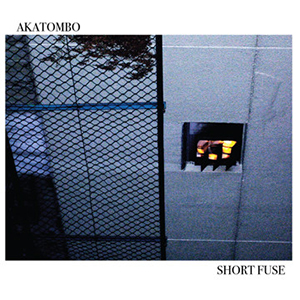 Given the current social climate across the world, it is not surprising at all that Paul Thomsen Kirk, the Scottish artist (by way of Hiroshima, Japan) has not lightened the mood on his latest work as Akatombo. Short Fuse is a direct follow-up to the 2015 release Sometime, Never, and continues his penchant for memorable rhythms paired with often abrasive electronics and obscure samples, coming together familiar and timeless at the same time his first vinyl release.
Given the current social climate across the world, it is not surprising at all that Paul Thomsen Kirk, the Scottish artist (by way of Hiroshima, Japan) has not lightened the mood on his latest work as Akatombo. Short Fuse is a direct follow-up to the 2015 release Sometime, Never, and continues his penchant for memorable rhythms paired with often abrasive electronics and obscure samples, coming together familiar and timeless at the same time his first vinyl release.
Kirk has always been a stickler for presentation, and this one is no different.Short Fuse is his first vinyl release as Akatombo, and still includes his normal handmade personal accents to the packaging, as well as a CD with the entire album plus three additional pieces that would not fit on the record.Like his previous work, the music contained recklessly plows through various subgenres of electronic while never settling into one:it is too loud to be downtempo, but the production is too nuanced to be made for crashing the dance floor, and so on.The beats are always strong, however, and the complex production is not easily dissected.
On some parts of the album, the touchstones are a bit more overt.With the pulsating synthesizer loops and processed drums, there is a distinctly 1980s industrial feel throughout "Project FEAR," exacerbated by his liberal (but appropriate) use of reverb.For "Tensile Strength," he throws in some excellently distorted, grinding bass synth layers and a multitude of voice samples, resulting in what could be a lost Wax Trax release circa 1989.Things are a bit different on "Haarp! The Herald," where a somewhat relaxed Middle Eastern ambience permeates into what could be a more chilled out version of Muslimgauze, without losing the unique Akatombo sound.
Many of the songs that are not as easily categorized feature the same level of dissonance and an overall bleak mood."The Incarceration of Habit," for example, is all a mass of dense, serrated metallic layers and grinding rhythms.Kirk piles on the instrumentation and effects, but it is exactly due to that heavy dissonance and multitracked beats that the piece stands out strongly.For "Tilt, Turn, Defenestrate," which is the CD-only closer to the album, he piles the layers on even more, for a mass of sound peppered with vocal samples that nudges into more traditionally noise territories.
Much of Short Fuse is aggressive and beat heavy, but Kirk knows how to keep things varied and dynamic."George Kaplan" is fragmented and deconstructed in its construction, putting more of the focus on the grimy textures and the intentionally overcast, foggy sounding production."Solitude in Numbers" is also a somewhat ambient work, with much of the thick mixing spread out to create an excellent sense of space and depth.Never dull, but Kirk’s choice to slowly drift passages in and out, rather than throw them all together, gives it a unique edge on an otherwise oppressive sounding record.
Previous Akatombo work has been exclusively in the digital format, but the analog sound benefits Short Fuse quite well, helping to bring out the subtleties to the production.The textures seem to have a greater depth, and the beats hit even harder.The album sounds fine on CD as well, and the extra bonus songs are appreciated, although I think Paul Thomsen Kirk made the right decision as far as what to include on the record and what would be considered ancillary material.Format philosophizing aside, however, what it really boils down to is that the new Akatombo record continues Kirk’s streak in the realm of dissonant, at times ugly, but always memorable rhythm heavy electronic music.It is a marvelous sounding and compelling form of oppression though, and quite possibly the best record he has made to date.
samples:
 
Read More

